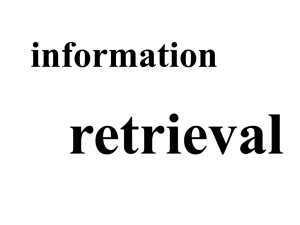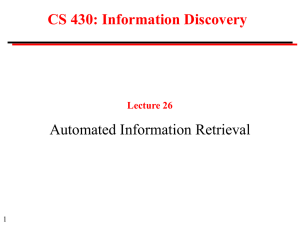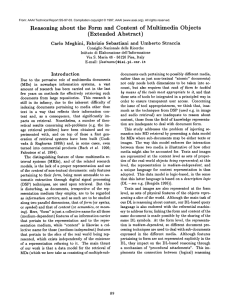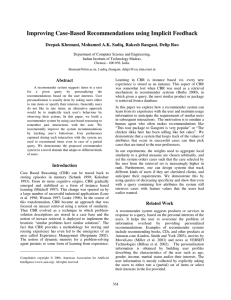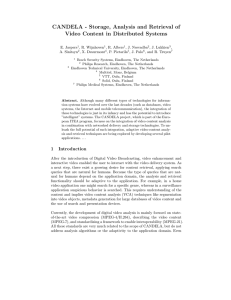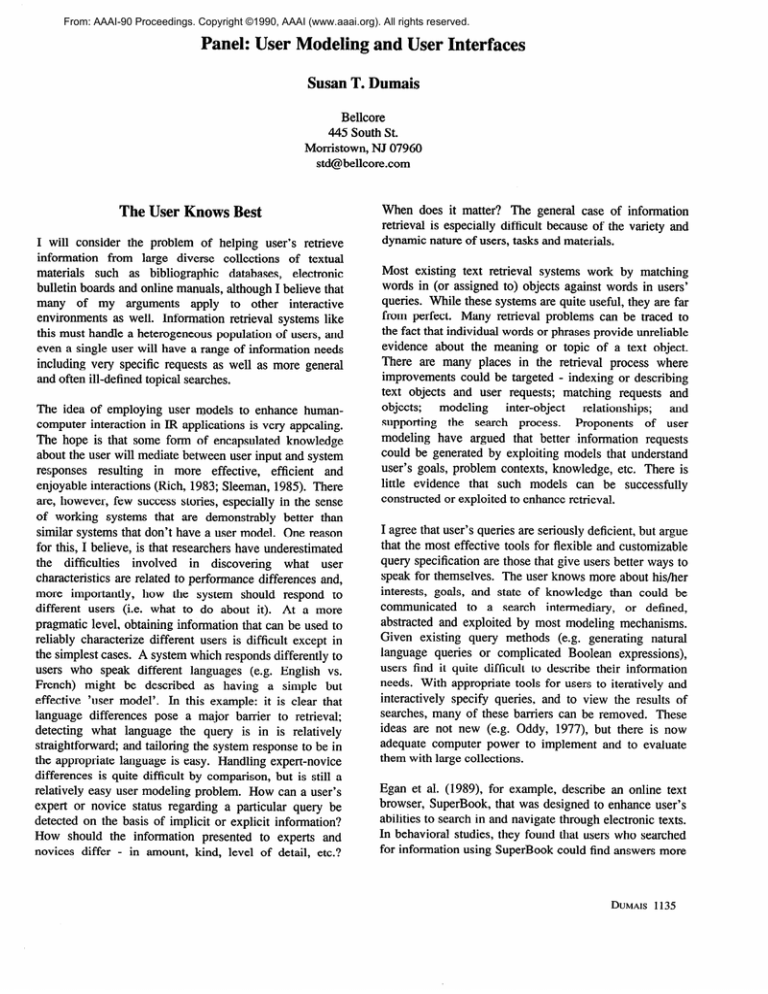
From: AAAI-90 Proceedings. Copyright ©1990, AAAI (www.aaai.org). All rights reserved.
Panel: User Modeling and User Interfaces
Susan T. Dumais
Bellcore
445 South St.
Morristown, NJ 07960
std@bellcore.com
The User Knows Best
I will consider the problem of helping user’s retrieve
information
from large diverse collections
of textual
materials
such as bibliographic
databases,
electronic
bulletin boards and online manuals, although I believe that
many of my arguments
apply to other interactive
environments
as well. Information retrieval systems like
this must handle a heterogeneous population of users, and
even a single user will have a range of information needs
including very specific requests as well as more general
and often ill-defined topical searches.
The idea of employing user models to enhance humancomputer interaction in IR applications is very appealing.
The hope is that some form of encapsulated knowledge
about the user will mediate between user input and system
responses
resulting
in more effective,
efficient
and
enjoyable interactions (Rich, 1983; Sleeman, 1985). There
are, however, few success stories, especially in the sense
of working systems that are demonstrably
better than
similar systems that don’t have a user model. One reason
for this, I believe, is that researchers have underestimated
the difficulties
involved
in discovering
what user
characteristics are related to performance differences and,
more importantly,
how the system should respond to
different users (i.e. what to do about it). At a more
pragmatic level, obtaining information that can be used to
reliably characterize different users is difficult except in
the simplest cases. A system which responds differently to
users who speak different languages (e.g. English vs.
French) might be described as having a simple but
effective ‘user model’. In this example: it is clear that
language differences pose a major barrier to retrieval;
detecting what language the query is in is relatively
straightforward; and tailoring the system response to be in
the appropriate language is easy. Handling expert-novice
differences is quite difficult by comparison, but is still a
relatively easy user modeling problem. How can a user’s
expert or novice status regarding a particular query be
detected on the basis of implicit or explicit information?
How should the information
presented to experts and
novices differ - in amount, kind, level of detail, etc.?
When does it matter? The general case of information
retrieval is especially difficult because of the variety and
dynamic nature of users, tasks and materials.
Most existing text retrieval systems work by matching
words in (or assigned to) objects against words in users’
queries. While these systems are quite useful, they are far
from perfect. Many retrieval problems can be traced to
the fact that individual words or phrases provide unreliable
evidence about the meaning or topic of a text object.
There are many places in the retrieval process where
improvements
could be targeted - indexing or describing
text objects and user requests; matching requests and
objects;
modeling
inter-object
relationships;
and
supporting
the search process.
Proponents
of user
modeling have argued that better information
requests
could be generated by exploiting models that understand
user’s goals, problem contexts, knowledge, etc. There is
little evidence that such models can be successfully
constructed or exploited to enhance retrieval.
I agree that user’s queries are seriously deficient, but argue
that the most effective tools for flexible and customizable
query specification are those that give users better ways to
speak for themselves. The user knows more about his/her
interests, goals, and state of knowledge than could be
communicated
to a search intermediary,
or defined,
abstracted and exploited by most modeling mechanisms.
Given existing query methods (e.g. generating natural
language queries or complicated
Boolean expressions),
users find it quite difficult to describe their information
needs. With appropriate tools for users to iteratively and
interactively
specify queries, and to view the results of
searches, many of these barriers can be removed. These
ideas are not new (e.g. Oddy, 1977), but there is now
adequate computer power to implement and to evaluate
them with large collections.
Egan et al. (1989), for example, describe an online text
browser, SuperBook, that was designed to enhance user’s
abilities to search in and navigate through electronic texts.
In behavioral studies, they found that users who searched
for information using SuperBook could find answers more
DUMAIS 1135
quickly and accurately than their counterparts who used a
paper version of the same book. The advantages
of
SuperBook come from: full-text indexing which increases
the likelihood that users will find the information they
need, the posting of matched query terms against a
dynamic hierarchical view of the document which enables
user to quickly find the most relevant passages; and
automatic page reformatting and highlighting to accentuate
The dynamic
the users’ current
search
interests.
hierarchical
display is a very simple kind of domain
model; but it is one that users understand and can exploit.
In bibliographic
retrieval situations where it is more
difficult to capitalize on inter- or intra-document
structure
other search enhancements
are often quite effective.
Retrieval performance can be improved by a number of
automatic
means
that encorporate
simple
statistical
information about the collection of objects and terms - e.g.
differentially term weighting or post-coordination
to rank
objects from most to least similar to the query. Larger
improvements
(averaging about 60%) can be obtained by
automatically
constructing
a new query based on user
feedback about which of the objects returned in response
to an initial query are relevant (Salton & McGill, 1983).
Since user’s initial queries are usually quiet impoverished,
the feedback process can be viewed as an easy and reliable
method
context-appropriate
for
generating
rich,
information requests.
In the two cases described above, the ability of users to
efficiently and effectively retrieve information was greatly
enhanced by providing them with flexible methods for
crafting queries and understanding the system’s responses.
References
Egan, D. E. et al. 1989. Formative design evaluation
SuperBook. ACM TOIS, 7(l), 30-57.
of
Oddy, R. N. 1977. Information
retrieval through manmachine dialogue. Journal of Documentation, 33, 1-14.
Rich, E. 1983. Users are individuals: Individualizing
user
models. International Journal of Man Machine Studies,
18, 199-214.
Salton, G. and McGill, M. J. 1983. Introduction
Modern Information Retrieval, McGraw-Hill, N.Y.
to
Sleeman, D. H. 1985. UMFE: A user modelling front-end
sub-system.
International
Journal of Man Machine
Studies, 23,71-88.
1136INVITED
TALKS
AND
PANELS




